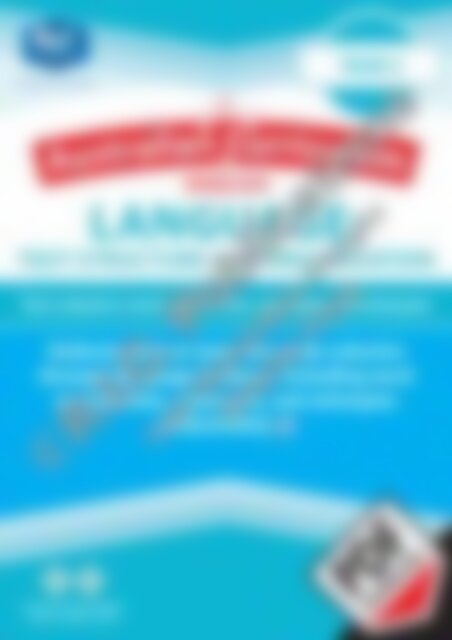20880 ACE Language (Yr 2) Text Cohesion
You also want an ePaper? Increase the reach of your titles
YUMPU automatically turns print PDFs into web optimized ePapers that Google loves.
Your partner in education<br />
YEAR 2<br />
ENGLISH<br />
LANGUAGE:<br />
TEXT STRUCTURE AND ORGANISATION<br />
<strong>Text</strong> cohesion: word association, synonyms and antonyms<br />
Understand how texts are made cohesive<br />
through language features, including word<br />
associations, synonyms, and antonyms<br />
(<strong>ACE</strong>LA1464)<br />
Australian Primary Publisher<br />
of the Year 2015 and 2016
Australian Curriculum English – <strong>Language</strong>: <strong>Text</strong> structure and organisation (Year 2)<br />
Foreword<br />
Australian Curriculum English – <strong>Language</strong>: <strong>Text</strong> structure and organisation (Year 2) is one in a series of seven teacher<br />
resource books that support teaching and learning activities in Australian Curriculum English. The books focus on<br />
the sub-strand of <strong>Text</strong> structure and organisation within the <strong>Language</strong> strand of the national English curriculum.<br />
The resource books include theoretical background information, activities to develop the content descriptions, blackline<br />
masters, resource sheets and assessment checklists, along with interrelated links to other English strands and sub-strands.<br />
Titles in this series are:<br />
• Australian Curriculum English – <strong>Language</strong>: <strong>Text</strong> structure and organisation (Foundation)<br />
• Australian Curriculum English – <strong>Language</strong>: <strong>Text</strong> structure and organisation (Year 1)<br />
• Australian Curriculum English – <strong>Language</strong>: <strong>Text</strong> structure and organisation (Year 2)<br />
• Australian Curriculum English – <strong>Language</strong>: <strong>Text</strong> structure and organisation (Year 3)<br />
• Australian Curriculum English – <strong>Language</strong>: <strong>Text</strong> structure and organisation (Year 4)<br />
• Australian Curriculum English – <strong>Language</strong>: <strong>Text</strong> structure and organisation (Year 5)<br />
• Australian Curriculum English – <strong>Language</strong>: <strong>Text</strong> structure and organisation (Year 6)<br />
Contents<br />
Format of this book .................................. iv – v<br />
<strong>Language</strong>: <strong>Text</strong> structure and<br />
organisation .............................................. 2–77<br />
Understand that different types of texts have<br />
identifiable text structures and language features<br />
that help the text serve its purpose (<strong>ACE</strong>LA1463)<br />
© Australian Curriculum: Assessment and Reporting Authority 2012<br />
–Teacher information ................................................. 2<br />
–Activities to develop the content description ........ 3–9<br />
–Blackline masters ............................................. 10–23<br />
–Assessment checklist ............................................. 24<br />
–Interrelated English links ........................................ 25<br />
– Modes, capabilities and priorities covered by the<br />
activities in this content description ........................25<br />
Understand how texts are made cohesive through<br />
resources, for example word associations,<br />
synonyms, and antonyms (<strong>ACE</strong>LA1464)<br />
© Australian Curriculum: Assessment and Reporting Authority 2012<br />
–Teacher information ............................................... 26<br />
–Activities to develop the content description ......... 27<br />
– Blackline masters and<br />
resource sheets ................................................ 28–36<br />
–Assessment checklist ............................................. 37<br />
–Interrelated English links ........................................ 38<br />
– Modes, capabilities and priorities covered by the<br />
activities in this content description ....................... 38<br />
–Teachers notes ....................................................... 39<br />
Recognise that capital letters signal proper nouns and<br />
commas are used to separate items in lists (<strong>ACE</strong>LA1465)<br />
© Australian Curriculum: Assessment and Reporting Authority 2012<br />
–Teacher information ............................................... 40<br />
–Activities to develop the content description .......... 41<br />
– Blackline masters<br />
and resource sheets ......................................... 42–48<br />
–Assessment checklist ............................................. 49<br />
–Interrelated English links ......................................... 50<br />
– Modes, capabilities and priorities covered by the<br />
activities in this content description ........................ 50<br />
–Teachers notes ........................................................ 51<br />
Know some features of text organisation including page and<br />
screen layouts, alphabetical order, and different types of<br />
diagrams, for example, timelines (<strong>ACE</strong>LA1466)<br />
© Australian Curriculum: Assessment and Reporting Authority 2012<br />
–Teacher information ................................................ 52<br />
–Activities to develop the content description ......... 53<br />
– Blackline masters<br />
and resource sheets ......................................... 54–75<br />
–Assessment checklist .............................................. 76<br />
– Modes, capabilities and priorities covered by the<br />
activities in this content description ........................ 77<br />
–Interrelated English links ......................................... 77<br />
Answers .....................................................78–82<br />
R.I.C. Publications ® www.ricpublications.com.au Australian Curriculum English – <strong>Language</strong>: <strong>Text</strong> structure and organisation (Year 2)<br />
iii
Format of the book<br />
This teacher resource book includes supporting materials for teaching and learning in the sub-strand of <strong>Text</strong> structure<br />
and organisation within the strand of <strong>Language</strong> in Australian Curriculum English. All content descriptions in the substrand<br />
have been included, as well as teaching points based on the Curriculum’s elaborations.<br />
While the book focuses on the sub-strand of <strong>Text</strong> structure and organisation, activities and interrelated links to other<br />
strands and sub-strands have been incorporated.<br />
Each section supports a specific content description and follows a consistent format, containing the following<br />
information over several pages:<br />
• activities to develop the content descriptions • student blackline masters • resource sheets<br />
• interrelated English links<br />
• assessment checklist<br />
Answers relating to student blackline masters have been included at the back of the book.<br />
The length of each content description section varies.<br />
Teacher information includes background information relating to the content description, as well as<br />
related terms and desirable student vocabulary and other useful details which may assist the teacher.<br />
Related terms includes vocabulary<br />
associated with the content description.<br />
Many of these relate to the glossary<br />
in the back of the official Australian<br />
Curriculum English document;<br />
additional related terms may also have<br />
been added.<br />
Student vocabulary includes words<br />
which the teacher would use—<br />
and expect the students to learn,<br />
understand and use—during English<br />
lessons.<br />
Further resources by R.I.C.<br />
Publications or other publishers<br />
or authors are included where<br />
appropriate.<br />
Activities to develop the content<br />
description includes descriptions or<br />
instructions for activities or games<br />
relating to the content descriptions<br />
or elaborations. Some activities are<br />
supported by blackline masters or<br />
resource sheets. Where applicable,<br />
these will be stated for easy reference.<br />
Understand that different types of texts have identifiable text structures and language features<br />
that help the text serve its purpose (<strong>ACE</strong>LA1463)<br />
© Australian Curriculum: Assessment and Reporting Authority 2012<br />
Related terms<br />
Teacher information<br />
<strong>Text</strong>s<br />
What this means<br />
?<br />
Written, spoken or multimodal forms of<br />
• Students should identify the text structures and language features of different<br />
communication for a range of purposes.<br />
imaginative, informative and persuasive text types including narratives, recounts,<br />
reports, procedures, explanations and expositions.<br />
<strong>Text</strong> structure<br />
• Students should understand that a text type is structured in a specifi c way to help<br />
The manner in which information is<br />
serve its purpose; e.g. a procedure is written in short steps with command verbs so it<br />
organised within different text types; e.g.<br />
can be followed easily, rather than in one paragraph with long sentences.<br />
table of contents, headings, topic sentences,<br />
sequencing.<br />
Teaching points<br />
T<br />
<strong>Language</strong> features<br />
• Students need to use the visual presentation of a text to identify the topic and text<br />
Features such as grammar, punctuation,<br />
type; i.e. view elements such as the cover design, packaging, title, author, subtitle<br />
sentence structure, type of vocabulary used,<br />
and illustrator (if either are included) and images displayed. <strong>Text</strong>s should not only be<br />
illustrations and diagrams that defi ne a text<br />
in the form of books, but be multimodal, such as a DVD.<br />
type.<br />
• Understanding the structure and features of a particular text type will improve a<br />
student’s comprehension of a text of this type.<br />
Imaginative texts<br />
• Opportunities to read, discuss and analyse a number of different examples of a<br />
<strong>Text</strong>s whose main purpose is to entertain.<br />
particular text type are a prerequisite for success in writing them.<br />
They may be in the form of traditional stories,<br />
poetry, plays, novels, picture books or fi lms for<br />
example.<br />
E Elaborations<br />
Informative texts<br />
E1. Uses the visual presentation and cover design of a text to identify the topic and text<br />
<strong>Text</strong>s whose main purpose is to provide<br />
information. They may be in the form of a<br />
type<br />
procedure, report or explanation for example.<br />
E2. Identifi es the text structures and language features of different text types.<br />
Persuasive texts<br />
<strong>Text</strong>s whose main purpose is to present a<br />
point of view and persuade a reader/listener/<br />
Further resources<br />
viewer. They may be in the form of a debate,<br />
advertisement or argument for example.<br />
• Primary writing (Books A–G) R.I.C. Publications<br />
• Posters: Introducing text types/Understanding text types R.I.C. Publications<br />
• Interactive software: Introducing text types (Understanding text types)<br />
R.I.C. Publications<br />
• 60 Writing topics: Exploring text types. Ages 5–7 Maureen Hyland<br />
Student vocabulary<br />
• Another 60 writing topics: Exploring text types. Ages 5–7 Maureen Hyland<br />
text<br />
complication<br />
narrative<br />
problem<br />
recount<br />
resolution<br />
report<br />
conclusion<br />
procedure<br />
ending<br />
explanation<br />
classification<br />
exposition<br />
description<br />
argument<br />
definition<br />
paragraph<br />
noun<br />
vocabulary<br />
verb<br />
title<br />
adjective<br />
orientation<br />
joining word<br />
<strong>Text</strong> structure<br />
and organisation<br />
events<br />
Australian Curriculum English www.ricpublications.com.au R.I.C. Publications ®<br />
2<br />
<strong>Text</strong> structure<br />
and organisation<br />
Understand that different types of texts have identifiable text<br />
Activities to<br />
structures and language features that help the text serve its purpose<br />
(<strong>ACE</strong>LA1463)<br />
develop the<br />
© Australian Curriculum: Assessment and Reporting Authority 2012 content description<br />
E1. Uses the visual presentation and cover design of a text to identify the topic and text type.<br />
• Examining book covers<br />
Provide a variety of different books, fi ction and nonfi ction, for students to examine the covers and predict the content of each book. Include picture<br />
books and short novels with illustrations; traditional tales from around the world, especially from Aboriginal and Torres Strait Islander cultures and those<br />
originating in Asia; myths and fables; comics; recipe books; and reference books on topics students are learning about. Revise/Discuss the features<br />
on the covers such as title, subtitle, author, illustrator and graphics/illustrations/images. Compare books. (Some will not have a subtitle or not list an<br />
illustrator.) Students predict what each book might be about.<br />
The list below are some suggested titles of books from Aboriginal and Asian cultures, and books written by Australian authors:<br />
Big rain coming K Germain and B Bancroft<br />
Growing up in Uluru S Breeden<br />
Tucker’s mob C A and J Mattingley<br />
Echidna and the shade tree Pamela Lofts<br />
Sisi and the cassowary A Meeks<br />
Possum Magic Mem Fox<br />
Sunday Chutney Aaron Blabey<br />
There’s a hippopotamus on our roof eating cake Hazel Edwards<br />
Sudsy Mom’s washing spree Waikiko Sato<br />
The restaurant of many orders Kenji Miyazawa<br />
Anna the goanna Jill Mc Dougall<br />
The ainu and the fox Shigeru Kayano<br />
Evaluating book covers (page 10)<br />
The blackline master can be used for students to work individually or in pairs to record their thoughts about what they think the cover of a chosen book<br />
means to them. Discuss the results of their evaluation using the bookworms at the bottom of the page. If their guesses were not very good, students<br />
may come to the conclusion that the cover design did not help them predict the content of the book.<br />
• Improving a cover design<br />
Students design a new, improved cover for their chosen book in the activity above, that they consider better reveals the content.<br />
• Design a DVD/book cover jacket (page 11)<br />
Students design a new DVD or book jacket for a favourite fi lm or book. This can be enlarged to A3.<br />
• Internet page<br />
Look at a webpage such as an informative text; (e.g. information on cheetahs at ) Discuss how the visual presentation, including title and images, helps the reader to identify what the page is about and<br />
what sort of information will be included in the rest of the text.<br />
• Venn diagram<br />
Make a Venn diagram comparing the cover of a selected book with the fi rst page of a digital text on a similar topic.<br />
• What’s it about?<br />
Give students a range of unfamiliar (i.e. not current popular children’s fi lms) DVD covers. Ask them to predict what the text is about and what type of<br />
text it is based on the title, images or packaging. Ask students to sort the DVDs according to their text type or topic.<br />
• Pop-ups<br />
Bring up a webpage with side advertising or pop-ups. Discuss how these are essentially the cover of an advertisement. What do they think will be in the<br />
text if they click on (open) the link? Discuss how these are often persuasive texts that are trying to get people to buy certain products.<br />
Interrelated English links: See page 25<br />
E2. Identifies the text structures and language features of different text types.<br />
• Analysing text structures and language features of various text types<br />
Pages 4 to 9 provide teacher information, student activities and examples of six imaginative, informative and persuasive text types written in the forms<br />
of a narrative, a recount, a procedure, a report, an explanation and an exposition.<br />
Each text type includes:<br />
– Information for the teacher about the various language and structural features of the specifi c text type.<br />
– A detailed analysis of the structural and language features of the text presented in the sample text provided on pages 12 to 23.<br />
– Suggested activities for helping students analyse structural and language features of the specifi c text type.<br />
– Answers for the student analysis worksheet (provided at the back of the book).<br />
Interrelated English links: See page 25<br />
? What this means<br />
provides a general<br />
explanation of the content<br />
description.<br />
T Teaching points<br />
provides a list of<br />
the main teaching points<br />
relating to the content<br />
description.<br />
E Elaborations are a<br />
list of elaborations<br />
based on those in the<br />
content description.<br />
R.I.C. Publications® www.ricpublications.com.au<br />
3<br />
Australian Curriculum English<br />
Australian Curriculum English – <strong>Language</strong>: <strong>Text</strong> structure and organisation (Year 2) www.ricpublications.com.au R.I.C. Publications ®<br />
iv
Format of the bookum.<br />
Blackline masters<br />
and resource sheets<br />
are provided to support<br />
teaching and learning<br />
activities for each content<br />
description. These include<br />
worksheets for class use,<br />
games, charts or other<br />
materials which the teacher<br />
might find useful to use or<br />
display in the classroom.<br />
For each blackline master or<br />
resource sheet, the content<br />
description to which it<br />
relates is given.<br />
Each section has a checklist<br />
which teachers may find useful as<br />
a place to keep a record of their<br />
observations of the activities to<br />
develop the content descriptions.<br />
Interrelated English links<br />
lists other links covered within<br />
the <strong>Language</strong> strand, Literature<br />
strand and Literacy strand of<br />
English that are incorporated in<br />
the activities provided with the<br />
content description. While the<br />
book’s approach focuses on the<br />
<strong>Text</strong> structure and organisation<br />
sub-strand, the links show the<br />
integration across the three<br />
strands.<br />
A table showing the <strong>Language</strong><br />
modes, General capabilities<br />
and Cross-curriculum priorities<br />
covered by the activities in each<br />
content description is provided.<br />
Answers for student worksheets<br />
are provided at the back of the<br />
book.<br />
R.I.C. Publications ® www.ricpublications.com.au Australian Curriculum English – <strong>Language</strong>: <strong>Text</strong> structure and organisation i (Year 2)<br />
v
<strong>Text</strong> structure<br />
and organisation<br />
Understand how texts are made cohesive through resources, for example word associations,<br />
synonyms and antonyms (<strong>ACE</strong>LA1464)<br />
© Australian Curriculum: Assessment and Reporting Authority 2012<br />
Related terms<br />
<strong>Text</strong>s<br />
Written, spoken or multimodal forms of<br />
communication for a range of purposes. <strong>Text</strong><br />
forms and conventions have been developed to<br />
enhance effective communication.<br />
<strong>Cohesion</strong><br />
Grammatical or lexical relationships that make<br />
links between different parts of a text and<br />
hold it together. <strong>Cohesion</strong> is achieved through<br />
devices such as paragraphs, connectives,<br />
ellipses and word associations.<br />
Word associations (lexical cohesion)<br />
The semantic relationships between words<br />
which form links within texts.<br />
Synonyms<br />
Words with the same or similar meaning<br />
Synonyms provide some variety in word choices,<br />
allowing the reader to focus on the ideas being<br />
presented.<br />
Antonyms<br />
Words with the opposite meaning<br />
Theme<br />
The main idea or message of a text<br />
?<br />
What this means<br />
Teacher information<br />
• In order for text to make sense, the ideas and words used in it are linked in different<br />
ways. Readers need to recognise some of these links and to know how to use them<br />
to understand the text.<br />
• Students should understand that there are many devices used to link or connect<br />
ideas and words in a text and that word association is one of them. Word<br />
associations can be made, for example, by using synonyms and antonyms.<br />
• Pronouns used as a synonym are a useful way of referring back to something<br />
previously mentioned. Highlighted pronouns in this passage are synonyms of ‘plans‘.<br />
If my plans don’t work out as I expect, they are discarded and I don’t try them<br />
again. Those that are successful are the ones I repeat.<br />
Teaching points<br />
• Many words found a in text are about the same thing and make links for the reader.<br />
• Because it would be boring and monotonous to keep repeating the same words,<br />
writers talk about the same thing in different ways.<br />
• A writer needs a good vocabulary to say the same thing differently.<br />
• Some words may have the same or a similar meaning, but words with the opposite<br />
meaning can be used to say the same thing too; e.g. small/not big.<br />
Elaborations<br />
E1. Maps word associations referring to particular characters in texts.<br />
E2.Connects similar and contrasts dissimilar information in text and identifi es how words<br />
are used to develop ideas and themes.<br />
Further resources<br />
Student vocabulary<br />
antonym<br />
synonym<br />
pronouns<br />
words<br />
similar<br />
opposite<br />
text<br />
theme<br />
vocabulary<br />
• Primary comprehension (Books B, C ) R.I.C. Publications ®<br />
• The comprehension box 1 R.I.C. Publications ®<br />
• http://kids.nationalgeographic.com/kids/animals/creaturefeature/<br />
galapagos-tortoise/<br />
• http://kids.nationalgeographic.com/kids/animals/creaturefeature/<br />
leatherback-sea-turtle/<br />
• Country Mouse and City Mouse<br />
http://www.youtube.com/watch?v=rAy1KljtAYQ<br />
Australian Curriculum English – <strong>Language</strong>: <strong>Text</strong> structure and organisation (Year 2) www.ricpublications.com.au R.I.C. Publications ®<br />
26
<strong>Text</strong> structure<br />
and organisation<br />
Understand how texts are made cohesive through resources, for<br />
example word associations, synonyms and antonyms (<strong>ACE</strong>LA1464)<br />
© Australian Curriculum: Assessment and Reporting Authority 2012<br />
Activities to<br />
develop the<br />
content description<br />
E1. Maps word associations referring to particular characters in texts.<br />
• Finding names (pages 28 and 29)<br />
(Related words are used in text to contribute to continuity of meaning, to avoid boring repetition and to maintain the reader’s interest. One way<br />
of doing this is by using different words, including pronouns, and phrases to refer to a particular character or characters.)<br />
Read the text ‘City Mouse and Country Mouse‘ on page 28 with the students. Work with the class to identify words used to refer to the characters City<br />
Mouse, Country Mouse or both of them. Work through the text highlighting words and phrases such as, ‘a little mouse‘, ‘he‘, ‘the visitor‘ that have been<br />
used to refer to City Mouse in one colour and words referring to County Mouse such as, ‘his’ friend and ‘him‘ in another colour. Words such as ‘the two<br />
mice‘; ‘they‘ referring to both mice can be highlighted in a third colour.<br />
Students can work through the text again with a partner and identify and write the words and phrases referring to the characters in the table on page<br />
29. They can then try to think of other appropriate words or phrases (synonyms) which could have been used to refer to the characters and write them in<br />
the table at he bottom of the page.<br />
• Finding words about a characteristic<br />
Work with the class on a piece of narrative text highlighting words and phrases used to tell about a particular characteristic of a character in a similar<br />
way to ‘Finding words‘. Categories could include: the character’s appearance, personality, behaviour, home and friends. Explain that all these words are<br />
related or linked to the one idea about the character and that they help the reader to understand more about the character.<br />
• Y charts of likes and dislikes (pages 30 and 31)<br />
(Y charts are three-part graphic organisers usually used to brainstorm ideas about a topic. Information is often organised into the three categories<br />
of what you can ‘see‘, ‘hear‘ and ‘feel‘. These two Y charts have been modified to map information referring to particular characters.)<br />
Students map word associations relating to the characters’ likes and dislikes on the two Y charts provided. They need to fi nd words relating to each<br />
mouse’s likes or dislikes and common ones too. Students may benefi t from completing these activities with a partner. This will provide opportunities for<br />
them to discuss and compare words chosen from the text.<br />
• Character profile (page 32)<br />
Students read the text ‘City Mouse and Country Mouse‘ on page 28 and look at the illustrations. They complete a profi le of one character by drawing<br />
a picture and fi nding words in the text that are associated with that character. These words are written on the page in one of these categories:<br />
‘appearance‘, ‘home‘ or ‘food‘.<br />
The table at the bottom of the page provides opportunities for students to write the words they used in their character profi le in the fi rst column. They<br />
search the text to fi nd, then record antonyms of the words they used. Synonyms of some of these words are then written in the third column. Some<br />
synonyms can be found in the text and others the students will need to work out for themselves.<br />
Interrelated English links: See page 38<br />
E2. Connects similar, and contrasts dissimilar information in text and identifies how words are used to<br />
develop ideas and themes.<br />
• All about us<br />
Discusss the concepts of same and different. Students work with a partner to make a list of fi ve things that are the same about the two of them and fi ve<br />
things that are different. They can share and compare their two lists with another pair. They then work with that pair to record fi ve things that are the<br />
same with all four of them and one thing that is unique to each student.<br />
• Finding information (pages 33 and 34)<br />
Read and discuss the text, ‘Turtles and tortoises‘ on page 33 with the students. Explain that like the students in their class, these two animals have<br />
special things about them. Words are used in the text to tell more about things to do with each animal. Work with them to identify words in the text<br />
relating to the ideas of what each animal looks like, where it lives and what its babies do. Students can work with a partner or individually to complete<br />
the worksheet; ‘Finding information‘ on page 34.<br />
• Same and different (page 35)<br />
Students use the information they wrote on page 34 to fi nd similarities and differences between turtles and tortoises.<br />
• Reptiles (page 36)<br />
A text such as the one on page 33 uses words which relate to a theme. The worksheet on page 36 requires students to think about the theme, ‘Reptiles‘<br />
and to fi nd any words linked to this theme in the text. They then extend their thinking to other words they know linked to this theme and search for and<br />
join any with the opposite meaning. Words expressing feelings about reptiles are also listed and synonyms circled. Students write one or two paragraphs<br />
on a separate page using many of the words on the page, linked to the theme.<br />
Interrelated English links: See page 38<br />
R.I.C. Publications ® www.ricpublications.com.au Australian Curriculum English – <strong>Language</strong>: <strong>Text</strong> structure and organisation (Year 2)<br />
27
City Mouse and Country Mouse<br />
A little mouse had lived in a busy city all his<br />
life. When his friend asked him to stay with<br />
him in the country, he was very excited.<br />
As soon as the visitor arrived, the two mice<br />
rushed out to play hide and seek. They had great fun running around in<br />
the sweet smelling corn. The sun was shining and it was very warm. They<br />
could hear birds singing, insects humming and leaves rustling. The tired<br />
mice felt warm and safe. Soon they both fell asleep.<br />
When the two friends woke up, they went into an old shed to eat corn<br />
and grain.<br />
‘I’ve always wanted to live in a warm, quiet and safe place,‘ said City<br />
Mouse, ‘but I miss the noise and rush of the city. Come home with me.<br />
You won’t believe all the sweet, tasty foods we have‘.<br />
‘Great,‘ said Country Mouse, ‘I’ve never been to the city‘.<br />
The next day they climbed on a train. When they arrived, cars and<br />
people were rushing around making lots of noise. The friends went into<br />
the beautiful big house where City Mouse lived.<br />
The two of them played games and had a great time. Then the hungry<br />
pair found bags of sugar in the pantry. They were having a feast when<br />
they heard a meow.<br />
‘The cat! Run, run, run!‘, yelled City<br />
Mouse.<br />
By the time the scared mice got<br />
down into a safe hole, poor Country Mouse<br />
was shaking with fear.<br />
After the cat left, they crept out and saw lots of<br />
party food on a table. They started nibbling at very<br />
tasty cherry pie. Then a woman came into the room.<br />
‘Run, run, run!‘, yelled City Mouse. They ran as fast as they could.<br />
‘This is not the life for me‘, said the frightened visitor. ‘I’m going home.<br />
The food is great, but I don’t like the danger. It is too noisy and it’s much<br />
too busy for me.‘<br />
Australian Curriculum English – <strong>Language</strong>: <strong>Text</strong> structure and organisation (Year 2) www.ricpublications.com.au R.I.C. Publications ®<br />
28<br />
City Mouse<br />
Country Mouse<br />
Understand how texts are made cohesive through resources, for example word associations, synonyms and antonyms (<strong>ACE</strong>LA1464)<br />
© Australian Curriculum: Assessment and Reporting Authority 2012
Finding names<br />
1. Write words and groups of words used to talk about the characters in<br />
the story, City Mouse and Country Mouse.<br />
City Mouse Country Mouse Both mice<br />
Understand how texts are made cohesive through resources, for example word associations, synonyms and antonyms (<strong>ACE</strong>LA1464)<br />
© Australian Curriculum: Assessment and Reporting Authority 2012<br />
2. Make up some other words and groups of words you could use to<br />
talk about the same characters.<br />
City Mouse Country Mouse Both mice<br />
R.I.C. Publications ® www.ricpublications.com.au Australian Curriculum English – <strong>Language</strong>: <strong>Text</strong> structure and organisation (Year 2)<br />
29
What the mice like<br />
Read the story City Mouse and Country Mouse carefully to find words<br />
that tell you what each mouse likes and what both the mice like. Write<br />
these words on the Y chart.<br />
Both mice<br />
City<br />
Mouse<br />
Country<br />
Mouse<br />
What the<br />
mice like<br />
Australian Curriculum English – <strong>Language</strong>: <strong>Text</strong> structure and organisation (Year 2) www.ricpublications.com.au R.I.C. Publications ®<br />
30<br />
Understand how texts are made cohesive through resources, for example word associations, synonyms and antonyms (<strong>ACE</strong>LA1464)<br />
© Australian Curriculum: Assessment and Reporting Authority 2012
What the mice don’t like<br />
Read the story City Mouse and Country Mouse carefully to find words<br />
that tell you what each mouse doesn’t like and what both the mice don’t<br />
like. Write these words on the Y chart.<br />
Both mice<br />
City<br />
Mouse<br />
Country<br />
Mouse<br />
Understand how texts are made cohesive through resources, for example word associations, synonyms and antonyms (<strong>ACE</strong>LA1464)<br />
© Australian Curriculum: Assessment and Reporting Authority 2012<br />
What the mice<br />
don’t like<br />
R.I.C. Publications ® www.ricpublications.com.au Australian Curriculum English – <strong>Language</strong>: <strong>Text</strong> structure and organisation (Year 2)<br />
31
Character profile<br />
1. Read the story City Mouse and Country Mouse and look at the<br />
pictures. Find words and information about one of the mice to draw<br />
the mouse and write in this character profile.<br />
Name:<br />
Mouse<br />
Appearance words:<br />
Home words:<br />
Food words:<br />
2. (a) In the My words column below, make a list of the words you used<br />
in Question 1 to tell about your character.<br />
(b) Write words from the text with the opposite meaning in the next<br />
column.<br />
(c) Think of words with the same meaning to write in the last column.<br />
My words<br />
Words with the<br />
opposite meaning<br />
Australian Curriculum English – <strong>Language</strong>: <strong>Text</strong> structure and organisation (Year 2) www.ricpublications.com.au R.I.C. Publications ®<br />
32<br />
Words with the same<br />
meaning<br />
Understand how texts are made cohesive through resources, for example word associations, synonyms and antonyms (<strong>ACE</strong>LA1464)<br />
© Australian Curriculum: Assessment and Reporting Authority 2012
Turtles and tortoises<br />
Turtles and tortoises are reptiles. They have scales and hard shells which<br />
they carry on their backs. They can’t ever leave their shells. As the<br />
animals gets older their shells keep growing and growing. Some of the<br />
older animals have really enormous shells. Tortoises have quite a high,<br />
domed shell, but turtles’ shells are lighter and flatter. When tortoises or<br />
turtles are in danger most of them hide in their<br />
shells.<br />
Understand how texts are made cohesive through resources, for example word associations, synonyms and antonyms (<strong>ACE</strong>LA1464)<br />
© Australian Curriculum: Assessment and Reporting Authority 2012<br />
Both of these reptiles have four legs, but they<br />
are very different. Turtles’ legs are more like<br />
flippers with webbed feet. Tortoises have bent<br />
legs and short feet with claws they can use for<br />
digging.<br />
Tortoises live on land and only go into water to drink or to have a wash.<br />
These land creatures are poor swimmers and they could drown if they<br />
fell into a river and were swept away. Turtles mainly live in water and<br />
they can swim very well. Turtles can swim to far-off places, but tortoises<br />
walk very slowly and usually stay close to where they were born.<br />
Most tortoises eat only plants like fruits and vegetables, but some turtles<br />
eat insects and fish as well as plants.<br />
Tortoises and turtles lay their eggs in a nest in the ground. Baby tortoises<br />
move from their nests soon after they hatch and they go to the burrow.<br />
Turtle eggs are in the nest for two to four months. Then the hatchlings<br />
have to make their way down to the water. It is a long, dangerous<br />
journey for these tiny turtles to make. As they try to get across the sand<br />
to the water, they are usually attacked and eaten by large numbers of<br />
birds. Even when they reach the water the hungry birds still get some of<br />
them.<br />
Turtles can live from 20 to 40<br />
years, but tortoises can live for<br />
80 to 150 years. Scientists know<br />
about one tortoise that lived for<br />
188 years. They think this is a<br />
record.<br />
R.I.C. Publications ® www.ricpublications.com.au Australian Curriculum English – <strong>Language</strong>: <strong>Text</strong> structure and organisation (Year 2)<br />
33
Finding information<br />
Read the text on page 33 to find and write words that tell what the two<br />
animals look like, where they live and what happens to their babies.<br />
Tortoises<br />
What they look like<br />
and do<br />
Where they live<br />
Their babies<br />
Turtles<br />
What they look like<br />
and do<br />
Where they live<br />
Their babies<br />
Understand how texts are made cohesive through resources, for example word associations, synonyms and antonyms (<strong>ACE</strong>LA1464)<br />
© Australian Curriculum: Assessment and Reporting Authority 2012<br />
Australian Curriculum English – <strong>Language</strong>: <strong>Text</strong> structure and organisation (Year 2) www.ricpublications.com.au R.I.C. Publications ®<br />
34
Same and different<br />
Read the words you wrote on page 34 and work out what’s the same and<br />
what’s different about tortoises and turtles.<br />
Appearance<br />
Same<br />
Different<br />
Understand how texts are made cohesive through resources, for example word associations, synonyms and antonyms (<strong>ACE</strong>LA1464)<br />
© Australian Curriculum: Assessment and Reporting Authority 2012<br />
Habitat<br />
Same<br />
Eggs and hatchlings<br />
Same<br />
Different<br />
Different<br />
R.I.C. Publications ® www.ricpublications.com.au Australian Curriculum English – <strong>Language</strong>: <strong>Text</strong> structure and organisation (Year 2)<br />
35
Reptiles<br />
1. Read the text on page 33 to find and write words that tell something<br />
about reptiles.<br />
2. (a) Write some other words you could use if you were talking about<br />
a different type of reptile. Think about what this reptile looks<br />
like and what it does.<br />
(b) Draw a line to join any two of your words that have the opposite<br />
meaning.<br />
3. (a) Write words you would use to tell how you feel about reptiles.<br />
(b) Draw circles around any of your words that have a similar meaning.<br />
4. Write one or two paragraphs about reptiles on a separate page. Use<br />
lots of the words you’ve written in the boxes.<br />
Australian Curriculum English – <strong>Language</strong>: <strong>Text</strong> structure and organisation (Year 2) www.ricpublications.com.au R.I.C. Publications ®<br />
36<br />
Understand how texts are made cohesive through resources, for example word associations, synonyms and antonyms (<strong>ACE</strong>LA1464)<br />
© Australian Curriculum: Assessment and Reporting Authority 2012
<strong>Text</strong> structure<br />
and organisation<br />
Understand how texts are made cohesive through resources, for<br />
example word associations, synonyms and antonyms (<strong>ACE</strong>LA1464)<br />
© Australian Curriculum: Assessment and Reporting Authority 2012<br />
Assessment<br />
checklist<br />
Student Name<br />
Identifies words<br />
and phrases used<br />
in written text to<br />
name a character/s<br />
in different ways<br />
(synonyms)<br />
Identifies pronouns<br />
used as synonyms<br />
for characters in<br />
written text<br />
Associates words<br />
and phrases used<br />
in written text with<br />
particular characters<br />
Identifies words<br />
and phrases used to<br />
develop a particular<br />
theme or idea,<br />
including synonyms<br />
and antonyms<br />
Identifies links in<br />
text which provide<br />
similar information<br />
Identifies and<br />
links dissimilar<br />
information in text<br />
R.I.C. Publications ® www.ricpublications.com.au Australian Curriculum English – <strong>Language</strong>: <strong>Text</strong> structure and organisation (Year 2)<br />
37
<strong>Text</strong> structure<br />
and organisation<br />
Understand how texts are made cohesive through resources, for<br />
example word associations, synonyms and antonyms (<strong>ACE</strong>LA1464)<br />
© Australian Curriculum: Assessment and Reporting Authority 2012<br />
Interrelated<br />
English links<br />
Below is a list of links within the <strong>Language</strong> strand, Literature strand and Literacy strand of English that are covered within the activities provided with the<br />
content description above.<br />
E1. Maps word associations referring to particular characters in texts.<br />
• Identify language that can be used for appreciating texts and qualities of people and things (<strong>ACE</strong>LA1462)<br />
• Discuss the characters and settings of different texts and discuss how language is used to present these features in different ways (<strong>ACE</strong>LT1591)<br />
• Identify language that can be used for appreciating texts and the qualities of people and things (<strong>ACE</strong>LA1462)<br />
• Recognise common prefi xes and suffi xes and how they change a word's meaning (<strong>ACE</strong>LA1472)<br />
• Write legibly with growing fl uency using unjoined upper case and lower case letters (<strong>ACE</strong>LY1673)<br />
E2. Connects similar, and contrasts dissimilar information in text and identifies how words are used to<br />
develop ideas and themes.<br />
• Understand the use of vocabulary about familiar and new topics and experiment with and begin to make conscious choices of vocabulary to suit<br />
audience and purpose (<strong>ACE</strong>LA1470)<br />
• Identify language that can be used for appreciating texts and qualities of people and things (<strong>ACE</strong>LA1462)<br />
• Reread and edit text for spelling, sentence-boundary, punctuation and text structure (<strong>ACE</strong>LY1672)<br />
• Write legibly and with growing fl uency using unjoined upper case and lower case letters (<strong>ACE</strong>LY1673)<br />
The above links are reproduced with permission from ACARA.<br />
© Australian Curriculum: Assessment and Reporting Authority 2012<br />
Modes, capabilities and priorities covered by the<br />
activities in this content description<br />
<strong>Language</strong> modes<br />
Listening<br />
General capabilities<br />
Literacy<br />
✔<br />
Speaking<br />
Reading<br />
Viewing<br />
Writing<br />
✔<br />
✔<br />
Numeracy<br />
Information and communication<br />
technology (ICT) capability<br />
Critical and creative thinking<br />
Personal and social capability<br />
Ethical behaviour<br />
Intercultural understanding<br />
Cross-curriculum priorities<br />
Aboriginal and Torres Strait Islander histories and cultures<br />
Asia and Australia’s engagement in Asia<br />
Sustainability<br />
Australian Curriculum English – <strong>Language</strong>: <strong>Text</strong> structure and organisation (Year 2) www.ricpublications.com.au R.I.C. Publications ®<br />
38
<strong>Text</strong> structure<br />
and organisation<br />
Understand how texts are made cohesive through resources, for<br />
example word associations, synonyms and antonyms (<strong>ACE</strong>LA1464)<br />
© Australian Curriculum: Assessment and Reporting Authority 2012<br />
Teachers notes<br />
Date<br />
Comments<br />
Further resources<br />
R.I.C. Publications ® www.ricpublications.com.au Australian Curriculum English – <strong>Language</strong>: <strong>Text</strong> structure and organisation (Year 2)<br />
39
<strong>Text</strong> structure<br />
and organisation<br />
Understand how texts are made cohesive through resources, for<br />
example word associations, synonyms and antonyms (<strong>ACE</strong>LA1464)<br />
© Australian Curriculum: Assessment and Reporting Authority 2012<br />
Answers<br />
Finding names ............................................. page 29<br />
1. Answers may include:<br />
City Mouse: a little mouse, he, him, the visitor, I, me<br />
Country Mouse: his friend, him, you, I, me, the frightened visitor<br />
Both mice: the two mice, they, the tired mice, the two friends, the<br />
friends, the two of them, the hungry pair, the scared mice<br />
2. Teacher check<br />
What mice like ............................................. page 30<br />
Answers may include:<br />
City Mouse: playing hide and seek, running in corn, feeling warm and<br />
safe, noise and rush, sweet, tasty food, playing games, sugar, feasts, party<br />
food, cherry pie,<br />
Country Mouse: playing hide and seek, running in corn, birds singing,<br />
insects humming, leaves rustling, quiet, corn and grain, feeling warm and<br />
safe, playing games, sugar, feasts, party food, cherry pie<br />
Both mice: playing hide and seek, running in corn, feeling warm and safe,<br />
sweet, tasty food, playing games, sugar, feasts, party food, cherry pie<br />
What mice don’t like ................................... page 31<br />
Answers may include:<br />
City Mouse: quiet places, corn and grain, cats, the woman<br />
Country Mouse: cats, the woman, danger, noise, busy places<br />
Both mice: cats, the woman<br />
Character profile ......................................... page 32<br />
1. -2. Teacher check<br />
Finding information .................................... page 34<br />
Answers may include:<br />
Tortoises: What they look like and do: have scales, hard shells on their<br />
backs, high domed shell, hide in shells, four legs, bent legs,<br />
short feet, claws, drink water, wash, walk very slowly, stay<br />
close, eat plants, lay eggs, hatch, go to burrows, live 80 to 150<br />
years<br />
Where they live: on land<br />
What the babies do: hatch, move from their nests, go to<br />
burrows, live 80 to 150 years<br />
Turtles: What they look like and do: have scales, hard shells on their<br />
backs, light fl at shells, hide in shells, four fl ipper legs, webbed<br />
feet, live mainly in water, swim well, swim to far-off places,<br />
eat plants, insects and fi sh, lay eggs, hatch, make their way to<br />
water, are attacked and eaten, live 20 to 40 years<br />
Where they live: mainly in water, in nests<br />
What the babies do: hatch, move from their nests, go to water,<br />
cross sand, attacked and eaten by birds, live 20 to 40 years<br />
Same and different ..................................... page 35<br />
Answers may include:<br />
Appearance:<br />
Same: have scales, hard shells on their backs, four legs<br />
Different: high domed shells/light fl at shells, bent legs and short feet/<br />
fl ipper legs<br />
Habitat:<br />
Same: in nests in ground<br />
Different: on land/mainly in water<br />
Eggs and hatchings:<br />
Same: hatch, move from their nest<br />
Different: go to burrows/ go to water, cross sand/don’t cross sand,<br />
attacked/not attacked and eaten by birds, live 80 to 150 years/<br />
live 20 to 40 years<br />
Reptiles ........................................................ page 36<br />
1. Answers may include:<br />
have scales, lay eggs, hatch<br />
2.-4. Teacher check<br />
R.I.C. Publications ® www.ricpublications.com.au Australian Curriculum English – <strong>Language</strong>: <strong>Text</strong> structure and organisation (Year 2)<br />
79


















